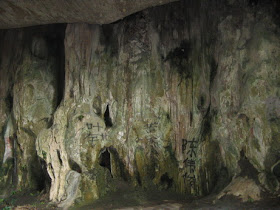I don't often post albums on individual caves, but as Waterfall Jan asked me about this one, which is of historical interest, I thought I would share it.
Mun Fatt Ngam, also called Cave of the Thousand Buddhas is in Gunung Mesah, just south of the Gopeng toll interchange, off the old trunk road, south of Ipoh, in Perak. I first went to the cave in 1994 and had forgotten about it. I remember on that visit we had trouble finding the cave. So this time, Sept 2009, I was surprised when the road ended at a prawn fishing pond.
A man working there guided us to the base of the stairs behind the pond and we began the long climb.
There are about 400 steps up the hill - I roughly counted 380 on the descent, but at the bottom there are no steps, they have disappeared over the years. The handrails are completely broken.
About 3/4 of the way up we saw a small cave on the left, so went in and surveyed it, and I named it Stairway Cave as its not in my Cave Register. It is only a small cave but has some interesting geological aspects.
Surveying Stairway Cave -
entrance wall Stairway Cave
Some monsoon rain meant we had to take shelter for a while before continuing to the top of the stairs.
pillar supporting stairs
We came out into a nice overgrown "garden" in front of the large entrance to Mun Fatt Ngam.
Nice garden
The entrance is impressive because of the white rock and the fluting (long grooves in a cave wall). The entrance is actually quite similiar to Gua Kanthan with its large size and also the fluting.
Looking out -
Mun Fatt Ngam consists of just a single chamber, approximately 150m long and 40m wide (we surveyed the cave but I don't have the figures yet). Apparently the cave was known in the 1880s - it was said to have been discovered before the founding of Kampar in 1886. It was used as a Taoist temple, and had its heyday during the days of tin mining.
Remains of a pillar
Inside a few altars have been made in front of natural stalagmites, but there are no longer any signs of the Buddhas.
There are several water tanks and the remains of wooden posts which may have been some form of pulley or maybe lighting. Apparently there used to be a pulley up the hill to hoist up supplies. At the entrance to the cave is a kitchen, with a stove to take 2 woks.
I was surprised there was no sign of soot on the stove, although the cave roof above was completely black. Several nails had been cemented into the cave wall to use as hooks.
The descent -
The temple was abandoned in 1969 after the Communist troubles. Mun Fatt Ngam should be treated as a heritage site as it is linked with the Chinese immigration into Malaya, as well as being an impressive cave.
Gunung Mesah from trunk road
See video taken by Jeroen.
© Liz Price
No reproduction without permission





























Thanks, Liz. Now even more interested to have a look myself...:-)
ReplyDeleteHave you ever wonder that at the peak of this hill is a crash site of a japanese world war 2 plane
ReplyDeleteI have not heard about that. Do you have any details?
Delete